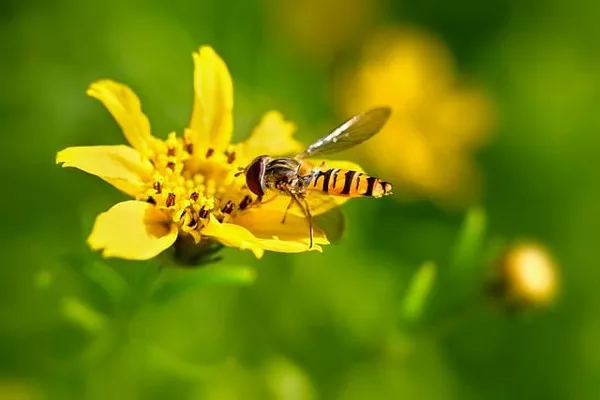In the intricate dance of nature, flowers and pollinators share a profound relationship that shapes ecosystems and sustains life. Among the countless pollinators, bees stand out as crucial contributors to this harmonious partnership. Their ability to navigate the world, particularly their perception of flowers, is nothing short of astounding. In this article, we will delve into the remarkable world of how a bee sees a flower, exploring the intricacies of their vision and the unique features that enable them to perform their vital pollination role.
The Complexity of Bee Vision
To understand how a bee sees a flower, we must first appreciate the complexity of their visual system. Bees, like many insects, possess compound eyes that differ significantly from the single-lens eyes of vertebrates. These compound eyes consist of thousands of individual photoreceptor units known as ommatidia, each functioning as a separate light-detecting unit. The number of ommatidia varies among bee species, with some possessing up to 5,000 per eye.
The advantage of compound eyes lies in their ability to provide a panoramic view of the world, allowing bees to detect fast movements and see a broader range of colors. However, this wide field of view comes at the cost of reduced visual acuity compared to human vision. While bees can detect motion and patterns effectively, they have difficulty resolving fine details.
The Spectrum of Color Vision
One of the most intriguing aspects of how bees see flowers is their perception of color. Bees, like many insects, have trichromatic color vision, meaning they possess three types of photoreceptor cells sensitive to different wavelengths of light. These photoreceptors are most sensitive to ultraviolet (UV), blue, and green wavelengths, enabling bees to perceive colors beyond the range of human vision.
In the world of a bee, flowers appear in a spectrum of hues, some of which are entirely invisible to the human eye. Flowers have evolved to take advantage of this disparity in color vision to attract their primary pollinators more effectively.
Ultraviolet Signposts: Nectar Guides
Bees rely heavily on ultraviolet patterns, or nectar guides, to locate and identify flowers with nectar. Nectar guides are intricate patterns or markings on flowers that act as visual signposts, guiding bees towards the nectar-rich regions of the flower. These patterns are often invisible to humans but stand out vibrantly to bees in the UV spectrum.
The nectar guides serve as essential beacons for bees, helping them efficiently navigate between flowers and reducing their search time for food sources. This visual cue is particularly vital in environments where numerous flowers are present, such as meadows or gardens.
Patterns and Shapes: Landing Pads
In addition to color perception, bees are sensitive to patterns and shapes on flowers, which influence their landing and feeding behavior. Certain flowers exhibit distinct patterns or markings, called landing pads, which direct bees towards the flower’s center where nectar and pollen are most abundant.
The shape and arrangement of these patterns guide bees towards the optimal landing position, ensuring efficient pollen transfer while minimizing wasteful attempts to access nectar. By understanding how a bee perceives these patterns, researchers and horticulturists can design more bee-friendly gardens and cultivate flowers that promote successful pollination.
Enhanced Sensitivity to Polarized Light
Beyond color and patterns, bees possess an extraordinary ability to detect polarized light. Light becomes polarized when it vibrates predominantly in one plane, and this phenomenon occurs in the sky due to scattering by air molecules. For bees, the ability to perceive polarized light serves as an invaluable navigational tool.
When bees forage for nectar, they often rely on the position of the sun as a reference point to find their way back to the hive. However, the sun’s position may not be readily visible on cloudy days or within dense vegetation. Here, the polarized light pattern in the sky serves as a backup compass, guiding bees to and from their food sources with impressive accuracy.
Floral Electric Fields: An Electrifying Discovery
Recent research has unveiled yet another fascinating aspect of how bees see flowers – their sensitivity to electric fields. Flowers, it turns out, generate weak electric fields, which can be influenced by factors such as humidity and light. When bees visit flowers, they become electrically charged due to friction between their bodies and the flower’s surface.
This discovery has opened up a new realm of investigation into the role of electric fields in the bee-flower interaction. Researchers speculate that bees might use electric cues to assess the quality of flowers, with electric charge possibly indicating the presence of abundant nectar.
The Role of Scent in Bee-Flower Communication
While this article focuses on the visual aspects of how bees see flowers, it’s essential to recognize the integral role of scent in bee-flower communication. Bees have an exceptional sense of smell, which helps them identify flowers from a distance and assess the availability of nectar.
Scent plays a crucial role in guiding bees towards flowers, especially in cases where visual cues might be challenging to perceive. Flowers emit volatile organic compounds, which act as chemical signals, enticing bees to visit and facilitate successful pollination.
Conclusion
The intricate dance between bees and flowers is a testament to the brilliance of nature’s design. The unique visual abilities of bees, such as their sensitivity to color, patterns, ultraviolet light, and polarized light, enable them to navigate the world of flowers with astonishing precision. Nectar guides, landing pads, electric fields, and scents all play integral roles in guiding bees towards flowers, facilitating pollination, and ensuring the continuation of plant life.
By gaining insight into how a bee sees a flower, scientists and horticulturists can create more bee-friendly environments, design gardens that promote pollination, and contribute to the conservation of these vital pollinators. As we marvel at the interplay of color, scent, and form in the bee-flower relationship, we deepen our understanding of the intricate connections that sustain life on our planet.


